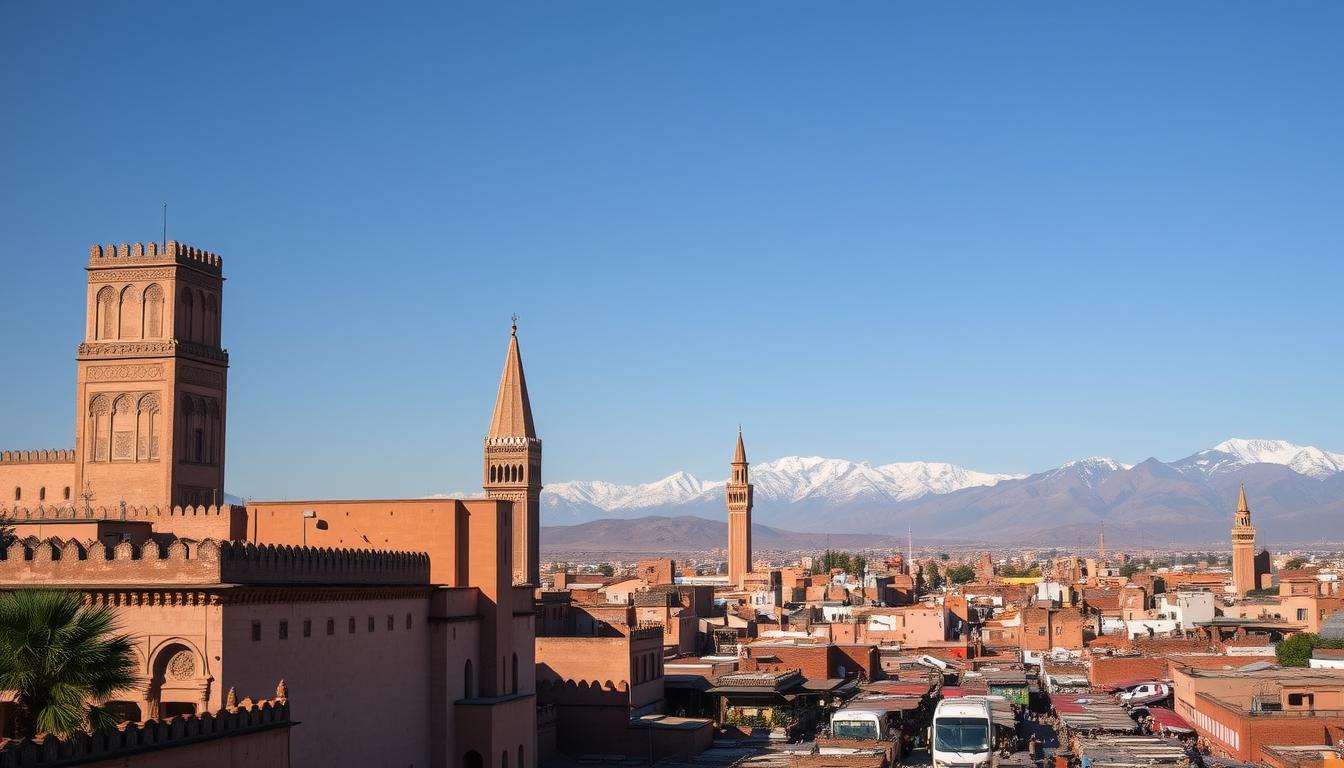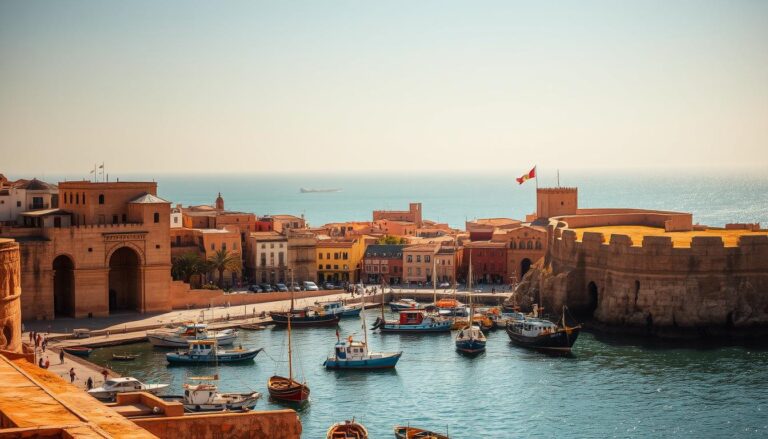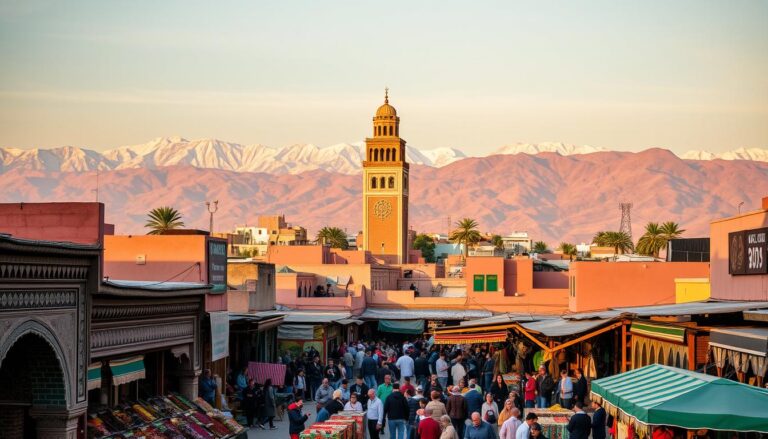Must-See Palaces & Historic landmarks in Marrakech
Planning a trip to Marrakech? You’re probably excited about the city’s rich history and architectural marvels. Marrakech, in Morocco, is famous for its lively souks and beautiful palaces.
In this guide, we’ll show you the top sites and Historic landmarks in Marrakech. You’ll learn about the history of these important sites. Plus, get tips for enjoying your visit.
Key Takeaways
- Explore Marrakech’s vibrant souks and stunning palaces
- Visit the most significant historic landmarks
- Discover the history behind Marrakech’s architectural marvels
- Get tips on how to make the most of your visit
- Experience the unique culture of Marrakech
Discover the Rich History of Marrakech
Marrakech’s history goes back to the Almoravid dynasty. As you explore this vibrant city, you’ll find layers of history. These layers have shaped Marrakech into the cultural hub it is today.
The Foundations of Marrakech
Marrakech was founded in 1070 AD by Abu Bakr ibn Umar. He was a leader of the Almoravid dynasty. The city’s location made it key for trade and commerce, linking the Sahara Desert to North Africa and beyond.
The Almoravids set the stage for Marrakech’s future success. They made it a significant heritage site.
Important Historical Events
Marrakech has seen many key events in its history. One was the rise of the Almohad dynasty in the 12th century. This made Marrakech a major city in Morocco.
The Almohads were famous for their buildings, like the Koutoubia Mosque. This mosque is one of Marrakech’s most famous landmarks. They also improved the city’s infrastructure, including irrigation systems.
Marrakech kept growing under the Saadians and Alaouites. Each dynasty left its mark on the city’s historical places. Today, visitors can see this history and experience Marrakech’s vibrant culture and rich heritage.
Majestic Palaces to Explore
Marrakech is famous for its stunning palaces. Each one has its own story of the city’s rich history. Exploring these places helps you understand Marrakech’s past and its cultural importance.
Bahia Palace: A Work of Art
The Bahia Palace was built in the late 19th century. It’s a showcase of Islamic craftsmanship. Its detailed woodwork and stunning tilework make it a top cultural spot in Marrakech.
Walking through the palace, you’ll notice the attention to detail. The skill of the craftsmen is truly impressive.
El Badi Palace: Once a Marvel
El Badi Palace was built in the 16th century. It was once a grand palace that showed the wealth of the Saadi dynasty. Though it’s now in ruins, it’s a key historical site.
The palace’s impressive architecture shows the engineering skills of the time. It gives a glimpse into the lives of those who lived there.
Here’s a comparison of the two palaces:
| Palace | Built | Notable Features |
|---|---|---|
| Bahia Palace | Late 19th century | Intricate woodwork, beautiful tilework |
| El Badi Palace | 16th century | Impressive architecture, historical significance |
Visiting these palaces takes you back in time. You get to see the grandeur of Marrakech’s past. Whether you love history, architecture, or culture, these palaces will make a lasting impression.
Iconic Mosques in the City
Exploring Marrakech, you’ll find iconic mosques that highlight the city’s rich culture and faith. These mosques are not just important religious spots. They are also architectural wonders that have lasted for centuries.
Koutoubia Mosque: A Landmark
The Koutoubia Mosque is a famous landmark in Marrakech, known for its tall minaret. It’s a masterpiece of Almohad architecture and a symbol of the city. The mosque is a stunning example of historic architecture, with detailed stonework and grand design.
Ben Youssef Mosque: Historical Significance
The Ben Youssef Mosque was once the biggest Islamic school in Marrakech. It’s famous for its beautiful tilework and historical importance. Exploring this mosque, you’ll see the ancient ruins of a past era, with its stunning tiles and decorations.
Visiting these iconic mosques will help you understand Marrakech’s religious and cultural practices. You’ll gain insight into the city’s history and the importance of these sites in Islam.
Vibrant Souks and Their Legacy
Marrakech’s souks are more than just markets. They open doors to the city’s rich culture and the artisans who keep traditions alive. Walking through the busy alleys, you’ll find a wealth of local crafts that show the city’s deep history.
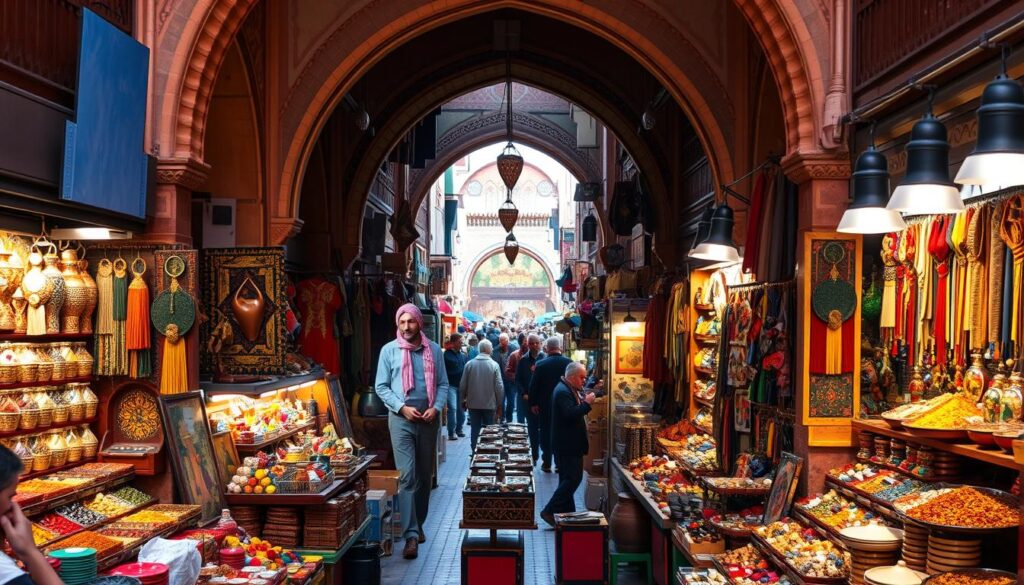
Explore the Markets of Marrakech
The souks are a world of sights, smells, and sounds. You’ll see bright colors, smell enticing scents, and hear merchants calling out. Here, you’ll find everything from fine textiles to metalwork, each piece telling a story of the artisan’s hard work.
Visiting the souks is more than just shopping. It’s a chance to see Marrakech’s history come alive. For centuries, these markets have been the city’s heart, where artisans show their work and the community gathers.
Handcrafted Treasures of the Souks
The souks are famous for their handmade treasures. You can find jewelry, pottery, and woodwork here. These items are not just beautiful; they also show Marrakech’s rich cultural heritage. Buying these crafts helps local artisans and keeps traditional skills alive.
Some of the highlights of the souks include:
- Intricately designed textiles and carpets
- Beautifully crafted metalwork and jewelry
- Unique pottery and ceramics
- Exquisite woodwork and furniture
Exploring Marrakech’s souks will deepen your understanding of the city’s culture and the artisans who preserve it.
The Saadian Tombs: A Hidden Gem
The Saadian Tombs are a hidden treasure in Marrakech. They are known for their detailed designs and calm vibe. As you explore, you’ll feel the beauty and peace that fills the tombs.
Architectural Wonders of the Tombs
The tombs are famous for their amazing architecture. They feature beautiful marble work and zellij tilework. These historic landmarks show the skill of the Saadi dynasty, who built them in the 16th century.
Walking through the tombs, you’ll see the fine details on the walls and ceilings. The marble and zellij tiles add to the luxury. At the same time, the calm atmosphere offers a quiet break from the city’s noise.
The Saadian Tombs give a special look into the lives of the Saadi sultans and their burial customs. You’ll learn about their history and importance. This makes your visit both enriching and memorable.
Visiting the Medina: Uncovering the Past
Explore the rich heritage of Marrakech by walking through the Medina’s ancient streets. The Medina of Marrakech, a UNESCO World Heritage site, is a maze of narrow alleys and historic sites. Each one tells a story of the city’s past.
Walking through the Medina, you’ll see a mix of architectural styles. These styles, from Islamic to Moorish, show the many cultures that have shaped Marrakech. The Medina is more than a place to visit; it’s an experience that brings Marrakech’s history to life.
Narrow Streets Packed with History
The narrow streets of the Medina are filled with historic buildings, busy souks, and important cultural landmarks. As you wander, you’ll find hidden treasures like traditional riads and ancient mosques. Each one has its own story to share.
Visiting the Medina lets you understand its deep historical significance. For centuries, the Medina has been Marrakech’s heart. It’s been a hub for trade, culture, and social life.
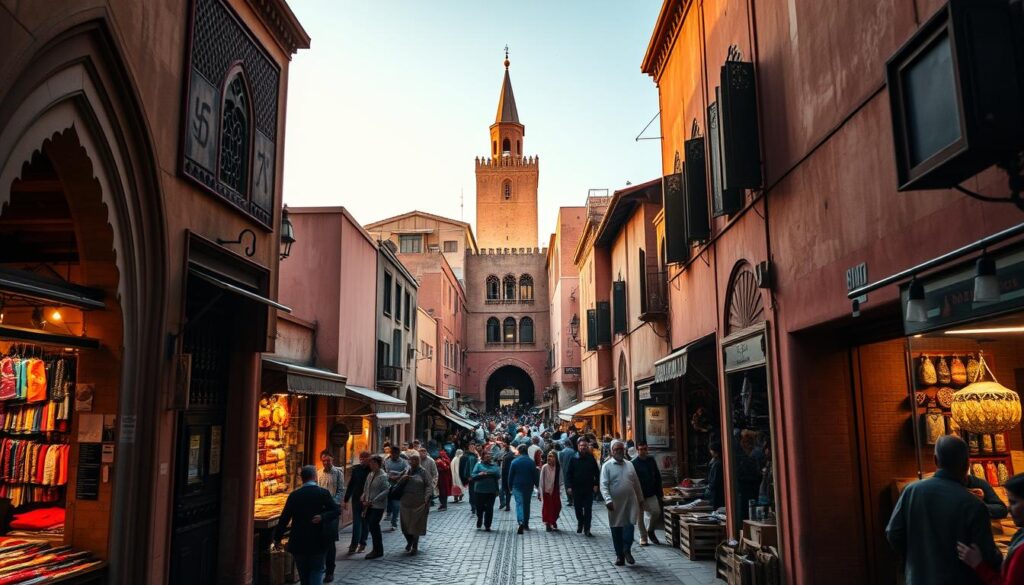
UNESCO World Heritage Designation
The Medina was named a UNESCO World Heritage site in 1985. This recognition highlights its cultural and historical value. It has helped protect the Medina and share its importance worldwide.
“The Medina of Marrakech is a masterpiece of Islamic art and architecture, reflecting the city’s rich history and cultural heritage.”
This designation has led to efforts to save and restore the Medina’s historic buildings. Visitors can see the amazing craftsmanship and architectural styles that have been kept intact.
| Aspect | Description | Significance |
|---|---|---|
| Architectural Style | Blend of Islamic, Moorish, and local influences | Reflects the cultural diversity of Marrakech |
| Historic Buildings | Riads, mosques, and traditional houses | Preserves the historical character of the Medina |
| Cultural Landmarks | Souks, squares, and religious sites | Highlights the Medina’s role in cultural and social life |
The Impact of French Colonialism
The French colonial era had a big impact on Marrakech. It shaped the city’s buildings and layout. You’ll see a mix of French and Moroccan styles as you walk around.
The French brought new building styles and city plans. They built the Ville Nouvelle, or New Town. It’s different from the old Medina.
The Ville Nouvelle: A Contrast
The Ville Nouvelle shows off French design. It has wide streets, cafes, and shops. It’s a big change from the Medina’s narrow paths.
“The Ville Nouvelle represents a significant aspect of Marrakech’s colonial past, showing a mix of French and Moroccan cultures.”
Walking through the Ville Nouvelle, you’ll see Art Deco and Art Nouveau. You’ll also see Moroccan touches. This mix shows Marrakech’s colonial history.
Historical Landmarks from the Colonial Era
Marrakech has many landmarks from the colonial time. The Mamounia Hotel is one of them. It’s famous for hosting Winston Churchill and Yves Saint Laurent.
| Landmark | Description | Significance |
|---|---|---|
| Mamounia Hotel | Luxury hotel with French and Moroccan designs | Hosted famous guests, showing Marrakech’s charm to visitors |
| Ville Nouvelle | New town from the French colonial era | Shows the mix of French and Moroccan cultures, unlike the Medina |
The French colonial era left a lasting mark on Marrakech. As you explore, you’ll see the rich culture from that time.
Gardens and Parks with a Story
Marrakech is not just about ancient ruins. It also boasts stunning gardens with their own stories. These peaceful places offer a calm break from the city’s noise. They also show off Marrakech’s rich cultural history.
Majorelle Garden: A Colorful Retreat
The Majorelle Garden was once a hideaway for French artist Jacques Majorelle. Today, it’s a colorful paradise with exotic plants and unique buildings. Walking through, you’ll hear the gentle sound of water and see plants in every color.
The garden’s mix of Berber and Art Deco styles is truly special. It’s a prime example of historic preservation in Marrakech.
Many garden lovers say the Majorelle Garden shows how art and nature can unite. This is clear in its beauty, where both art and nature blend perfectly.
Menara Gardens: A Peaceful Escape
The Menara Gardens offer a calm break from Marrakech’s busy streets. They’re centered around a big water reservoir and show classic Moroccan design. Visitors can enjoy the quiet, take in the views, and see the historic preservation at work.
“The Menara Gardens are a must-visit destination for anyone looking to experience the tranquility of Marrakech’s natural beauty.” This quote highlights the significance of the gardens as a peaceful retreat.
In conclusion, Marrakech’s gardens and parks are more than just green spaces. They reflect the city’s culture and history. By visiting, you support historic preservation and see Marrakech’s beauty beyond its ancient ruins.
Cultural Festivals Celebrating History
You’re invited to see the best of Marrakech’s culture at its many festivals. These events show the city’s lively cultural scene. They highlight Marrakech as a place where artists and visitors come together.
Marrakech International Film Festival
The Marrakech International Film Festival is a top event. It draws filmmakers and movie lovers from everywhere. It celebrates global cinema, focusing on films that show cultural diversity and history.
Key Highlights of the Festival:
- Screenings of international and Moroccan films
- Workshops and panels with industry professionals
- Awards ceremony to recognize outstanding cinematic achievements
Festival of World Sacred Music
The Festival of World Sacred Music is a big deal in Marrakech. It features performances that show the spiritual and cultural heritage of many traditions. This festival lets you experience music’s universal language.
| Festival Aspect | Description | Significance |
|---|---|---|
| Performers | Musicians from diverse cultural backgrounds | Showcases global musical heritage |
| Venue | Historic sites and cultural landmarks in Marrakech | Enhances the cultural experience |
| Repertoire | Sacred music from various religious and cultural traditions | Promotes interfaith understanding and cultural exchange |
By going to these festivals, you’ll understand Marrakech’s rich culture and history better. The city’s mix of tradition and modernity shines during these events.
Tips for Exploring Marrakech’s Historical Sites
Getting ready to see Marrakech’s historic spots? Knowing the best ways to visit these sites will make your trip better. Marrakech’s old buildings tell a story of the past. By respecting local ways, you’ll get the most out of these places.
Optimal Visiting Times
Visit Marrakech’s sites when it’s cooler, like in the morning or late afternoon. This helps keep these old buildings safe. It’s good for both you and the sites.
Essentials for Your Journey
When you go to Marrakech’s landmarks, dress modestly and wear comfy shoes. Don’t forget sun protection like a hat and sunscreen. Being ready lets you enjoy the history and culture these sites share.

